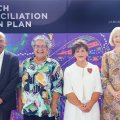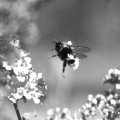State-of-the-art equipment and complementary technical know-how at the University of Queensland's Centre for Microscopy and Microanalysis (CMM) are turning heads around the world.
The Centre is dedicated to an understanding of the structure and composition of all materials, biological and non-biological, at atomic, molecular, cellular and macromolecular levels.
It boasts equipment, assets and facilities worth more than $6 million and employs upwards of 40 people including scientists and technical support staff.
Recently a visiting American academic, who had seen on the Internet what CMM had to offer, sought out the facility to examine about 50 lichen samples he had collected while in Australia and South Pacific islands.
During the two days Professor Samuel Hammer spent at St Lucia, the specimens were first plasma-coated with platinum and imaged in a field emission scanning electron microscope.
Professor Hammer was delighted with the assistance he received and the quality of the high-resolution images produced at the Centre.
Professor Hammer, who teaches biology at Boston University's College of General Studies, arrived in Australia on May 20 for a six-week visit.
He said his travel and laboratory work were being funded by a $25,000 grant from National Geographic and he was hoping a story and photographs about his research during the trip would appear in the world-famous magazine.
Professor Hammer is comparing species of lichen in the northern and southern hemispheres. He said some species were common to both hemispheres but around 500 to 600 species were found only in the southern half of the world.
He described his research as "floristic and biogeographic". This meant he was studying where species grew, trying to compare the growth dynamics between the two hemispheres and seeking to discover how lichens had evolved over time.
Professor Hammer said the technology he was able to use at UQ was a "great tool" for his work and complemented other more traditional equipment such as standard optical microscopes.
It may not be long, however, before Professor Hammer and other researchers will make equally good use of this University's electron microscope facilities without even leaving home.
CMM scientific officer Duncan Waddell said systems were now in place which allow academics and researchers to conduct microscopy and microanalysis from anywhere in the world via the Internet.
"It will be just the same as if they were sitting in the room here with us," said Mr Waddell, creator of the Centre's website.
"They will see the microscope images in real-time and be able to guide the operator to photograph or analyse exactly what they need. We can then immediately transmit to them, via the Internet, high resolution digital photos of what they have been seeing."
Mr Waddell said the website had been up and running since 1994. "Our website was one of the first at the University of Queensland and over 140,000 visitors have been recorded to date.
"The site has won numerous awards and has recently been featured in the prestigious scientific journal Science. We're getting worldwide results and feedback, and this is not the first time it has directly attracted international clients."
For further information, contact Duncan Waddell (telephone 3365 4216).



